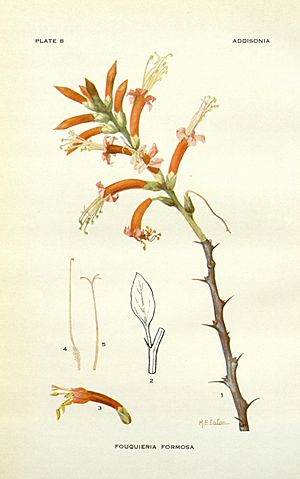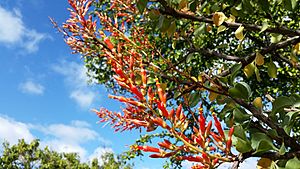Fouquieria formosa facts for kids
Quick facts for kids Fouquieria formosa |
|
|---|---|
 |
|
| Conservation status | |
| Scientific classification | |
| Genus: |
Fouquieria
|
| Species: |
formosa
|
Fouquieria formosa is a special plant that grows in central and southern Mexico. People call it by many names like palo santo, rabo de iguana, rosalillo, tlapacon, corona de Cristo and flor de jabon. It's a type of plant that lives for many years.
About This Plant
Fouquieria formosa is a small tree that can grow up to 8 meters (about 26 feet) tall. Its bright flowers are often visited by hummingbirds, which help to pollinate them. Other birds might also use the flowers. Sometimes, carpenter bees and bumblebees visit too. They might even make small cuts on the flowers to get to the nectar.
What it Looks Like
This plant is a small tree, usually 3 to 8 meters (10 to 26 feet) tall. It often has one or two main trunks at its base, which can be quite thick. The bigger stems branch out many times, with lots of younger stems growing upwards or spreading wide.
The outer layer of the plant, called the periderm, is smooth. It can be dark bronze or yellow and peels off in thin, papery pieces. The larger stems and trunks are often green.
The branches have spines, but their length can be different depending on where the plant grows. Some spines are very short, while others can be up to 20 mm (almost an inch) long. Some plants might even have almost no spines at all!
The plant has short flower clusters with large, bright orange-red to yellow-orange flowers. These flowers have petals that curve downwards. The number of stamens (the parts that produce pollen) can also vary. Plants of this species can look quite different from each other across their range. This means things like spine length and stamen count can change based on the environment.
Where it Grows
This plant likes to grow on rocky slopes and in valleys. It can be found in different types of soil, from reddish, iron-rich soils to chalky soils. Its home stretches from Jalisco to southeastern Oaxaca in Mexico.
You can find Fouquieria formosa in different kinds of environments. These include tropical forests where trees lose their leaves in the dry season, and dry tropical areas with scrubby plants. It grows at different heights, from high up in the mountains (2400 meters or about 7,900 feet) down to lower areas (100 meters or about 330 feet) near Tehuantepec in Oaxaca.
Most of the rain in its habitat falls from June to September. The plant usually flowers from October to February, but it can sometimes flower all year long.
The way the plant looks can change depending on its environment. For example, in dry areas of Puebla and Oaxaca, the plants often have smooth stems, long spines, and smaller flowers. They also tend to have more stamens. But in the wetter highlands of Morelos and Mexico, the plants might have shorter spines and fewer stamens.
See also
 In Spanish: Fouquieria formosa para niños
In Spanish: Fouquieria formosa para niños



